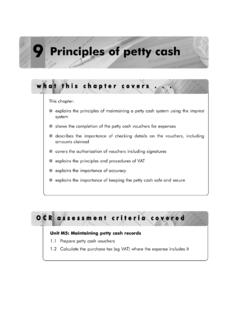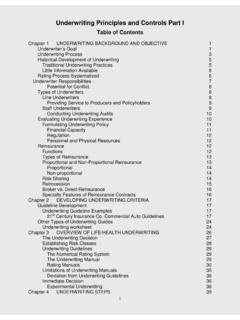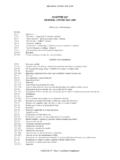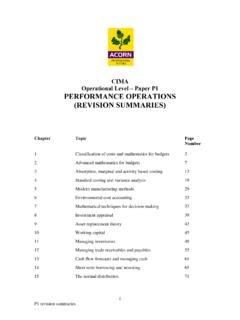Transcription of 8 INVENTORY VALUATION - osbornebooksshop.co.uk
1 INVENTORIESC ompanies often have inventories in various forms: raw materials, for use in a manufacturing business work-in-progress (partly manufactured goods) and finished goods (ready for sale) of amanufacturing business products bought for resale by a retailer service items, such as stationery, bought for use within a business INVENTORY is often kept in the stores or storeroom of a company and the person who looks after it isthe VALUATION8 Companies may have inventories held in the form of raw materials, work-in-progress, finished goods, products bought for resale, and serviceitems. Often the value of such inventories is high, representing aconsiderable sum of money and so it is important that it is valuedconsistently, and proper controls are kept over the physical this chapter we look at: VALUATION of inventories, including the application of IAS 2, Inventories FIFO (first in, first out) and AVCO (average cost ) methods of inventoryvaluation use of a stores ledger record or INVENTORY card to calculate the valueof closing INVENTORY effect on profits, in the short-term, of different methods of inventoryvaluation advantages and disadvantages of FIFO and AVCO importance of the INVENTORY count and INVENTORY 03/07/2012 16:03 Page 200inventory VALUATION 201 VALUATION OFINVENTORYThe inventories held by a business invariably have considerable value and tie up a lot of money.
2 Atthe end of the financial year, it is essential for a company to make a physical INVENTORY count and tovalue its INVENTORY for use in the financial statements in the calculation of profit, and for the balancesheet. This physical INVENTORY count involves the company staff counting each item held. Theinventory held is then valued as follows:number of items held x cost per item = INVENTORY valueThe auditors of a company may make random checks to ensure that the INVENTORY value is value of INVENTORY at the beginning and end of the financial year is used to calculate the figure forcost of sales. Therefore, the INVENTORY value has an effect on profit for the can be valued at either: cost , which means the purchase price plus any other costs incurred to bring the product (orservice) to its present location and condition, or net realisable value, which is the estimated selling price less the estimated costs to get the productinto a condition necessary to complete the saleInventory VALUATION is normally made at the lower of these two values, ie at the lower of cost and netrealisable VALUATION is taken from International Accounting Standard (IAS) No 2, VALUATION applies the prudence concept and is illustrated by the following diagram:value INVENTORY at cost pricevalue INVENTORY at selling price(net realisable value)NOYESis cost price lower than selling price?
3 The principle of INVENTORY 03/07/2012 16:03 Page 201202A2 Accounting for AQAWORKED EXAMPLE: INVENTORY VALUATION situationThe Clothing Store Limited bought a range of beachwear in the Spring, with each item costing 15 andretailing for 30. Most of the goods sell well but, by Autumn, ten items remain unsold. These are put on thebargain rail at 18 each. On 31 December, at the end of the store's financial year, five items remain what price will they be included in the year end INVENTORY VALUATION ?Twelve months later, three items still remain unsold and have been reduced further to 10 each. At what pricewill they now be valued in the year end INVENTORY VALUATION ?solution At 31 December, the five items will be valued at a cost of 15 each, ie 5 x 15 = 75. Twelve months later, the three items remaining unsold will be valued at a net realisable value of 10each, ie 3 x 10 = note: Inventories are never valued at selling prices when selling prices are above cost reason for this is that selling prices include profit, and to value INVENTORY in this way wouldrecognise the profit in the financial statements before it has been OFINVENTORYVALUATIONThe difficulty in INVENTORY VALUATION is in finding out the cost price of INVENTORY this is not easy whenquantities of a particular INVENTORY item are continually being bought in often at different prices and then sold.
4 Some companies have INVENTORY in a number of different forms, eg a manufacturer maywell have raw materials, work-in-progress and finished 2, Inventories, allows companies to use one of two methods to calculate the cost price of theirinventory:FIFO (first in, first out) In this method, the first (oldest) inventories acquired are assumed to be used first. This means thatthe INVENTORY on hand at any time is assumed to consist of the most recently acquired (average cost )In this method, the weighted average cost of items held at the beginning of the year is calculated,using the formula: weighted average cost =total cost of goods in INVENTORY number of items in 03/07/2012 16:03 Page 202 The weighted average cost is then used to value goods sold. A new weighted average cost must becalculated each time that further inventories are bought during the year. Note that the use of a particular VALUATION method does not necessarily correspond with the methodof physical distribution adopted in the stores of the business.
5 For example, in a car factory one carbattery of type X is the same as another, and no-one will be concerned if the storekeeper issues onefrom the last batch received, even if the FIFO system has been adopted. However, perishable goodsare always physically handled on the basis of first in, first out, even if the INVENTORY records use theAVCO chosen a suitable INVENTORY VALUATION method, a business would continue to use that methodunless there were good reasons for making the change. This is in line with the consistency concept INVENTORY values stores ledger recordIn order to be able to calculate accurately the price at which materials are issued and to ascertain avaluation of INVENTORY , a stores ledger record or INVENTORY card is used, as shown below. Thismethod of recording INVENTORY data is also used in the Worked Example which LEDGER RECORDNote the following points: the layout of the stores ledger record or INVENTORY card may vary slightly from one business toanother many businesses use a computer system for their INVENTORY records a blank stores ledger record, which may be photocopied, is available for free download from theResources section of whilst it is good learning practice to use a stores ledger record, many examination questionsrequire a calculation of INVENTORY value this can be completed without a stores ledger recordinventory VALUATION 203 DateReceiptsIssuesBalance TotalTotalTotalQuantity cost cost Quantity cost cost Quantity cost cost Note that this price is the cost price to thebusiness.
6 It is not the selling price INVENTORY records are usually kept at 03/07/2012 16:03 Page 203204A2 Accounting for AQAWORKED EXAMPLE: STORES LEDGER RECORDS situationAshok Patel runs a computer supplies company. One of the items stocked is the Zap data show how the stores ledger records would appear under FIFO and AVCO, the following data is used:20-7 JanuaryOpening INVENTORY of 40 units at a cost of eachFebruary Bought 20 units at a cost of eachMarchSold 36 units for 6 eachApril Bought 20 units at a cost of eachMaySold 25 units for 6 eachWhat will be the profit for the period using the two INVENTORY VALUATION methods?solutionNote: In the FIFO method, units issued at the same time may be valued at different costs. This is becausethe quantities received, with their costs, are listed separately and used in a specific order. There may beinsufficient units at one cost , eg see the May issue, LEDGER RECORDDateReceiptsIssuesBalance 20-7 Quantity cost Total Quantity cost Total Quantity cost TotalCostCostCost Jan Balance40 20 4 20 19 : In the Balance columns, a new list of INVENTORY quantities and costs is started after each receipt orissue.
7 When INVENTORY is issued, costs are used from the topof the list 03/07/2012 16:03 Page 204 AVCOIn this method, each quantity issued is valued at the weighted average cost per unit, and so is the balancein INVENTORY . The complete list of different costs does not have to be re-written each LEDGER RECORDDateReceiptsIssuesBalance 20-7 Quantity cost Total Quantity cost Total Quantity cost TotalCostCostCost Jan Balance40 20 24 20 19 : Weighted average cost is calculated by dividing the quantity held into the value of the INVENTORY . Forexample, at the end of February, the weighted average cost is 192 60 units = , and at the end ofApril it is 44 = closing INVENTORY valuations at the end of May 20-7 under the two methods show total cost prices of:FIFO difference comes about because different INVENTORY VALUATION methods have been on profitIn the example above, the selling price was 6 per unit.
8 The effect on gross profit of using different inventoryvaluations is shown Sales: 61 units at INVENTORY : 40 units at :20 units at units at Closing INVENTORY : 19 of profit = Sales cost of VALUATION 03/07/2012 16:03 Page 205206A2 Accounting for AQAN otice that the cost of sales figure is also obtainable by adding up the values in the Issues can also check this, both in Units and in Values:opening INVENTORY + receipts issues = closing inventoryThe Worked Example shows that in times of rising prices, as here, FIFO produces the higher reportedprofit and AVCO the lower. The reason for this is that, here, FIFO gives a higher closing INVENTORY ,which means that cost of sales is lower and profit is higher; by contrast, AVCO gives a lower closinginventory, which means that cost of sales is higher and profit is lower. Although the profit difference inthis Worked Example is not significant, to a large company the difference could be a considerablemoney amount.
9 However it is important to note that, over the life of a business, total profit is the same,whichever method is chosen: the closing INVENTORY of one period becomes the opening INVENTORY ofthe next and, in this way, profit is allocated to different years depending on which method is ANDDISADVANTAGES OFFIFO ANDAVCO FIFO (first in, first out)advantages it is realistic, ie it assumes that goods are issued in order of receipt it is easy to calculate INVENTORY VALUATION comprises the actual costs at which items have been bought the closing INVENTORY VALUATION is close to the most recent costs it is one of the two methods which IAS 2, Inventories, allows companies to use acceptable for tax purposesdisadvantages costs at which goods are issued are not necessarily the latest prices, so cost of sales may notrepresent current prices in times of rising prices, profits are higher than with other methods (resulting in more tax to pay) the method is cumbersome as the list of different costs must be maintainedAVCO (average cost )
10 Advantages over a number of accounting periods reported profits are smoothed, ie both high and low profitsare avoided fluctuations in purchase costs are evened out so that issues per unit do not vary greatly logical, ie it assumes that identical units, when purchased at different times, have the same value closing INVENTORY VALUATION is close to current market values (in times of rising prices, it will bebelow current market values) the calculations can be computerised more easily than the other methods it is one of the two methods which IAS 2, Inventories, allows companies to use acceptable for tax 03/07/2012 16:03 Page 206inventory VALUATION 207disadvantages a new weighted average has to be calculated after each receipt, and calculations may be to severaldecimal places because they are averaged, issues and INVENTORY VALUATION are usually at costs which never existed issues may not be at current costs and, in times of rising prices, will be below current costsThe important point to remember is that a business must adopt a consistent INVENTORY valuationpolicy, ie it should choose a method of finding the cost price, and not change it without good and AVCO are the two methods allowed under IAS 2, Inventories, and a company might decide touse FIFO for one type of INVENTORY and AVCO for another.














